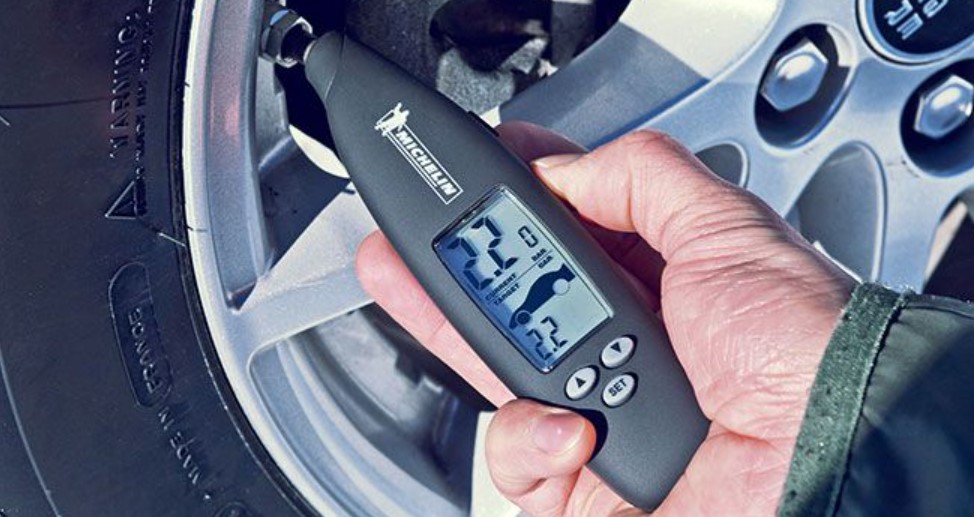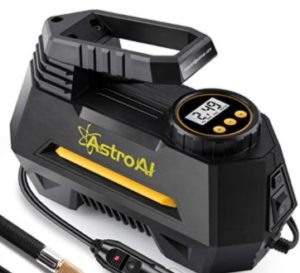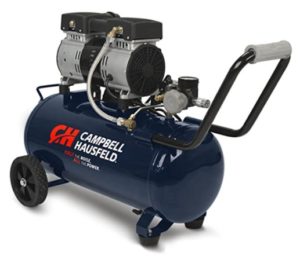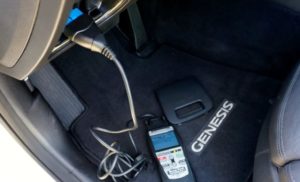Checking pressure in your tire and keeping them filled has become easier today due to technology. Nowadays, you don’t rely on tire gauge to check the pressure for your tires. Several digital sensors are there you can use. You should review the gas in your tires often, especially during winter, as gas tends to fluctuate more.
How Often Should You Check Pressure?
Since pressure fluctuates more in winter, keep checking your tires once in a couple of weeks or a month. You don’t depend only on your tire pressure monitoring system to warn you if pressure drops. During summer, heat causes the air inside the tires to expand but has less impact than in winter. The tire loses about one psi per month.
The rule to check the pressure once a month, even in summer it’s advisable. You can make it a routine to monitor your tire pressure every time you approach your vehicle. Find a handheld pressure gauge at a hardware store or online shop.
Why Should You Care About Tire Pressure?
- Overinflated tires can be hectic as they increase the number of treads in contact with the ground, meaning your car has less stability and traction.
- They are also susceptible to a blowout.
- Underinflated tires wear out faster because the wheels are compensating for the low pressure. Tires overheat, losing their trends more quickly.
- Well, inflated tires save you money at the gas pump and fuel too. Again, they are best for your safety when driving.
Tire Pressure Loss. What’s Normal?
It’s imperative to check your tire pressure regularly to avoid any inconveniences. Suppose a tire loses more than 25% of the manufacturer’s recommended pressure, possibilities of tire-caused crash increases. A loss of 1-3 psi per month is common, and you should always re-inflate the tires.
Neglecting the inflation for months may cause significant loss, which is risky. If the tire loss increases to more than 1-3psi per month, its an alarm; there may be other factors affecting. They include;
Temperatures
During freezing times, the tire loses 2% every 10 degrees F drop and rises with every 10 degrees F temperatures increase. One should re-inflate tires in winter as the temperature difference between summer and winter can be about 50 degrees F.
A Bad Pressure Valve
If the tire loses pressure overtime for more than 3psi, you need to replace your valves. The valves may get damaged due to chemical exposure, promoting pressure loss.
Bent or Damaged Wheel
A wheel wit a lost shape will not hold the tire on it. The bent area allows some air out of the tire, and it may become flat in a couple of days.
Tire Damage
The damage will let out air directly, no matter how small it is. Nails, beads, or other items may cause tire damage. Nails damage can let out 2-3 psi daily and even cause a blowout.
How to Check Tire Pressure at Home
Check your tire pressure through the following steps;
- Purchase a tire pressure gauge
- Find the required pressure level of your car. You can find the information on a yellow placard on the door jamb or owner’s manual. It may contain different pressure levels for the front and rear tires.
- Check tires pressure when tires are cold or in the morning when the ambient temperature is low.
- Unfix the valve cap and set it aside.
- Press the gauge onto the valve stem; it takes a few seconds to get an accurate reading. Get the pressure readings on the gauge screen.
- Compare the tire pressure readings with the amount as per manufactures guidelines. If the measured pressure is below the recommended, you need to re-inflate the tires.
Here are some other gauges you can use to check your car tire pressure or even hook them up to a compressor to inflate the tires where necessary.
-
AstroAI Digital Tire Pressure Gauge
It’s a gauge that helps measure correct tire pressure and also has a 12V compressor that you can use to fill up the tires.
Features
- Non-slip texture for easy holding
- Automatic resets when taking pressure
- It’s slim and portable
- Nozzle lights at night for visibility
- Ergonomic design for all gender
- Has four settings range
- Ability to measure up to 150 psi
How to Use It
Press the turn on button on the gauge and select the range. Then place the nozzle on the valve stem, and it will give quick and accurate in 0.1 increments. Note the readings before the gauge automatically shuts-off.
Check Price-
Campbell Haus Feld (MP600000AV)
It a 3-tools in one compact contains an inflator gun, chuck, and gauge. You use it with your air compressor to achieve proper tire inflation.
Features
- 2 inches readable gauge with a range of 10-150 psi
- Inflation gun with side relief valve
- Flexible hosepipe
Pros
- User-friendly design
- Easy to operate
- Has a seamless connection
Cons
- The indicator may be inaccurate sometimes
-
Tymate Tire Pressure Monitoring System
It is a digital TPMS that monitors tire pressure also senses high temperature and leakage. Its widely used on most 4-wheel like SUV, Minibus, and more.
Features
- Power saving mode
- Switch button
- Low power consumption
- Long working life sensor
- Five types of alarm modes
- Multiple charging methods
Pros
- Accurate in pressure measurements
- Easy to install
- Small to be obtrusive
- Low power consumption
Cons
- Display a bit smaller
What is the Ideal Pressure for Your Car?
The recommended care tire pressure is between 30-35 psi. These numbers indicate the minimum amount of air pressure needed to support your maximum vehicle load-carrying capacity. When the tires’ air becomes less than the set level, fuel consumption increases and compromises your car handling. When overinflated, the tires have less grip on the road and are more prone to bursting.
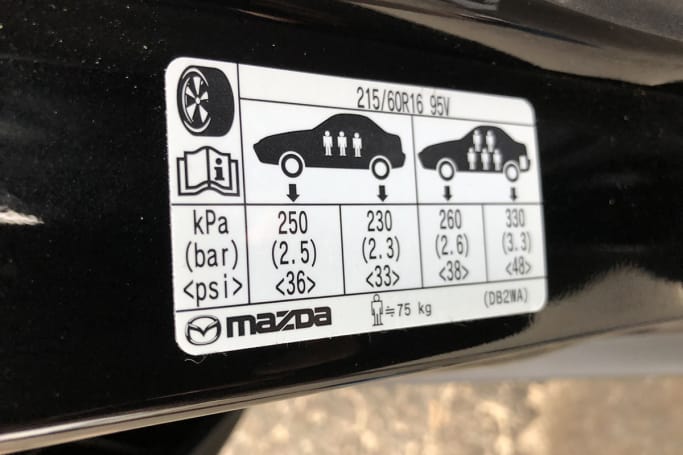
You can check the correct tire pressure of your car in the following places;
- At Vehicles Door
On the door jamb, you will find a sticker with the numbers.
- Your Vehicles Handbook
Mostly for the old vehicles, they don’t have a sticker, but at least you can get the psi rating here.
- Online
You can search online, specifically on the manufacturer’s website.
- On the Fuel Filler Door
- On the Tire
- On the Sidewalls
It contains the maximum load capacity and maximum inflation pressure.
Here are some general pressure levels based on tire sizes. Note that you should still consider your car model’s recommended tire pressure especially if your car is still running on the tires it shipped from the assembly line with.
| Tire Size | Front Tires | Rear Tires |
|---|---|---|
| 205/55R16 | 2.5 bar/ 36 psi | 2.4 bra/ 35psi |
| 215/60R17 | 2.3 bar/ 33psi | 2.3 bar/ 33psi |
| 205/60R16 | 2.4bar/ 35psi | 2.2bar/ 32psi |
| 235/55R18 | 2.2bar/ 32psi | 2.2bar/ 32psi |
| 225/65R17 | 2.2bar/ 32psi | 2.2bar/ 32psi |
Can You Check Tire Pressure Without a Gauge?
Though using a gauge is the most accurate way to check tire pressure, sometimes you may not have it. Below are DIY ideas that can help check pressure manually ;
Hand Pressure
Check the pressure by pushing the tire with your hand. If the feel is soft, you need to inflate more gas. If the tire feels firm like a rock, it might be fine.
Weight on Wheels
You can put maximum load capacity on wheels. If the tire deforms by at least 10 %, it shows the pressure is low. It would help if you, therefore, inflate the tire until there is no room for deformity.
Eyeball Method
It’s easy, but one should be an expert to apply it. Watch tire pressure from a little distance. First, keep your vehicle on a flat level and then observe. If the tires seem to protrude out one or two millimeters on each side, they need more gas. But remember to avoid over-inflation.
How to Inflate Your Car Tire Without a Pump?
A flat tire may occur in the middle of nowhere, and maybe you don’t have a portable air compressor. Frankly, the easiest way out is being prepared and buying a portable air compressor that runs off your 12V battery or off a jumper pack. Here are some options:
- tire pressure gauge
- Find the required pressure level of your car. You can find >AstroAI Air Compressor Tire Inflator
- tire pressure gauge
- Find the required pressure level of your car. You can find >EPAuto 12V DC Portable Air Compressor Pump
- tire pressure gauge
- Find the required pressure level of your car. You can find >FORTEM Digital Tire Inflator
There is no safe and reliable way to inflate your tires well without using any form of a pump or a compressor. If you don’t have a compressor at hand and your car doesn’t have an onboard compressor, you could opt to use a tire pressure gauge
Find the required pressure level of your car. You can find >valve equipped bike pump (again, buy a portable compressor instead of buying the bike pump).
Here is how to inflate a tire with a bike pump.
- Park your car in a safe flat area.
- Remove the valve caps and keep them safe.
- Determine the optimal pressure for your car tires from either manual, placards.
- Check the pressure in the tires using a gauge and calculate how much the tires need.
- Attach the pump to the tire valve.
- Pump up your tire and adjust the pressure as necessary.
Conclusion
Keep it a routine to check your tire pressure regularly once in a couple of weeks. But you can still do frequently depending on the season and other road-related factors. The pressure review will save you cost on fuel consumption and replacing tires in case of underinflation. Again, you will keep yourself safe on the road and avoid the possibilities of crashing or even been stranded alone.
